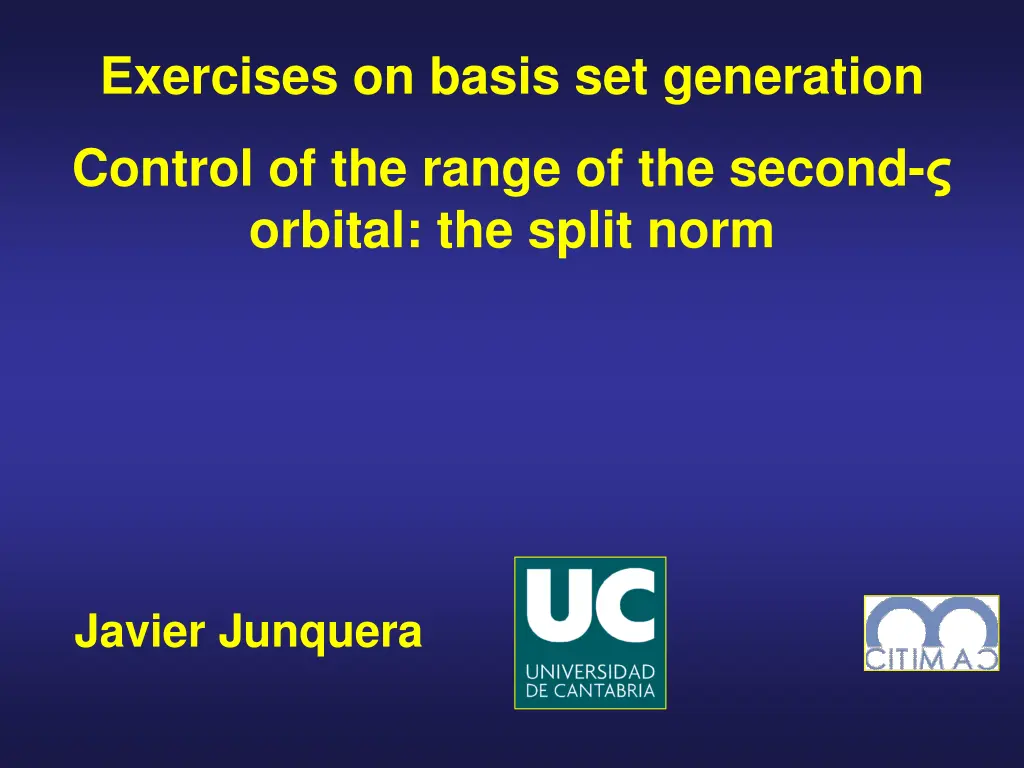
Mechanism for Generating Multiple Orbitals in SIESTA
Explore the split-valence method in SIESTA for generating multiple orbitals efficiently. Learn about controlling orbital range and the significance of PAO SplitNorm parameter in this comprehensive lecture by Javier Junquera.
Uploaded on | 1 Views
Download Presentation

Please find below an Image/Link to download the presentation.
The content on the website is provided AS IS for your information and personal use only. It may not be sold, licensed, or shared on other websites without obtaining consent from the author. If you encounter any issues during the download, it is possible that the publisher has removed the file from their server.
You are allowed to download the files provided on this website for personal or commercial use, subject to the condition that they are used lawfully. All files are the property of their respective owners.
The content on the website is provided AS IS for your information and personal use only. It may not be sold, licensed, or shared on other websites without obtaining consent from the author.
E N D
Presentation Transcript
Exercises on basis set generation Control of the range of the second- orbital: the split norm Javier Junquera
Default mechanism to generate multiple- in SIESTA: Split-valence method Starting from the function we want to suplement
Default mechanism to generate multiple- in SIESTA: Split-valence method The second- function reproduces the tail of the of the first- outside a radius rm
Default mechanism to generate multiple- in SIESTA: Split-valence method And continuous smoothly towards the origin as (two parameters: the second- and its first derivative continuous at rm
Default mechanism to generate multiple- in SIESTA: Split-valence method The same Hilbert space can be expanded if we use the difference, with the advantage that now the second- vanishes at rm (more efficient)
Default mechanism to generate multiple- in SIESTA: Split-valence method Finally, the second- is normalized rm controlled with PAO.SplitNorm
Meaning of the PAO.SplitNorm parameter PAO.SplitNorm is the amount of the norm (the full norm tail + parabolla norm) that the second- split off orbital has to carry (typical value 0.15)
Bulk Al, a metal that crystallizes in the fcc structure Go to the directory with the exercise on the energy-shift More information at the Siesta web page http://www.icmab.es/siesta and follow the link Documentations, Manual Inspect the input file, Al.energy-shift.fdf As starting point, we assume the theoretical lattice constant of bulk Al FCC lattice Sampling in k in the first Brillouin zone to achieve self-consistency
For each basis set, a relaxation of the unit cell is performed Variables to control the Conjugate Gradient minimization Two constraints in the minimization: - the position of the atom in the unit cell (fixed at the origin) the unit cell lattice vectors to 60 - the shear stresses are nullified to fix the angles between , typical of a fcc lattice
The splitnorm: Variables to control the range of the second- shells in the basis set
The splitnorm: Run SIESTA for different values of the PAO.SplitNorm Then, run SIESTA Edit the input file and set up PAO.SplitNorm 0.10 $siesta < Al.splitnorm.fdf > Al.splitnorm.0.10.out
For each splitnorm, search for the range of the orbitals Edit each output file and search for:
For each splitnorm, search for the range of the orbitals Edit each output file and search for: We are interested in this number
For each splitnorm, search for the range of the orbitals Edit each output file and search for: The lattice constant in this particular case would be 2.037521 2 = 4.075042
For each energy shift, search for the timer per SCF step We are interested in this number
The SplitNorm: Run SIESTA for different values of the PAO.SplitNorm Then, run SIESTA Edit the input file and set up PAO.SplitNorm 0.15 $siesta < Al.splitnorm.fdf > Al.splitnorm.0.15.out Try different values of the PAO.EnergyShift PAO.SplitNorm 0.10 $siesta < Al.splitnorm.fdf > Al.splitnorm.0.10.out PAO.SplitNorm PAO.SplitNorm 0.25 PAO.SplitNorm 0.20 $siesta < Al.splitnorm.fdf > Al.splitnorm.0.20.out $siesta < Al.splitnorm.fdf > Al.splitnorm.0.25.out $siesta < Al.splitnorm.fdf > Al.splitnorm.0.30.out 0.30
Analyzing the results Edit in a file (called, for instance, splitnorm.dat) the previous values as a function of the SplitNorm
Analyzing the results: range of the orbitals as a function of the split norm $ gnuplot $ gnuplot> plot splitnorm.dat" u 1:2 w l, splitnorm.dat" u 1:3 w l $ gnuplot> set terminal postscript color $ gnuplot> set output range-2zeta.ps $ gnuplot> replot The larger the SplitNorm, the smaller the orbitals
